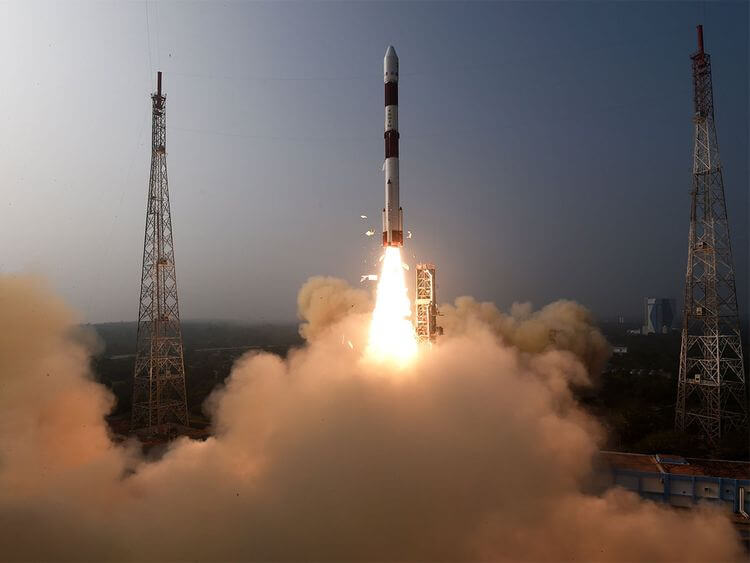India launched its X-ray Polarimeter Satellite (XPoSat) into orbit on Monday to celebrate the start of a new year in grandeur.
India’s Polar Satellite Launch Vehicle-C58 (PSLV-C58), which is 44.4 meters tall and has a liftoff mass of 260 tons, launched from the first launch pad at the Satish Dhawan Space Centre , Sriharikota (Andhra Pradesh) at approximately 9.10 a.m. on January 1, 2024.
On its fourth stage, the rocket carried XPoSat together with ten additional experimental payloads.
The people gathered at the viewing gallery applauded proudly as the rocket, which had a strong orange flame at its tail, slowly rose towards the skies. It gained speed with a sound like rolling thunder and continued to rise, leaving behind a thick plume.
It’s interesting to note that on January 1, this is the Indian Space Research Organization’s (ISRO) first space mission.
Approximately 21 minutes into the mission, the rocket launched XPoSat at a height of approximately 650 kilometers.
ISRO Chairman S. Somanath stated following the launch: “The orbit completed for XPoSat is excellent as the deviation is just three kilometers.” The satellite’s solar panels are now in place.
The PSLV is a four-stage, engine-powered disposable rocket that may run on liquid or solid fuels. Six booster motors are attached to the first stage of the rocket to provide additional thrust during the opening stages of flight.
The five PSLV rocket types operated by the ISRO are Standard, Core Alone, XL, DL, and QL.
The usage of strap-on boosters, which in turn mostly depends on the weight of the satellites to be orbited, is the main distinction between them.
In the PSLV-XL, QL, and DL versions, the PSLV employs 6,4,2 solid rocket strap-on motors to increase the thrust given by the first stage, accordingly. Nevertheless, the PSLV-CA core-alone version does not use strap-ons.
The first ISRO scientific satellite specifically designed to conduct research on space-based polarization measurements of X-ray radiation from astronomical sources is called XPoSat. The IMS-2 bus platform is used as a model for the modified satellite configuration. The IRS satellite legacy forms the basis for the mainframe systems’ setup. POLIX (Polarimeter Instrument in X-rays) and XSPECT (X-ray Spectroscopy and Timing) are its two payloads.
The POLIX is realised by the Raman Research Institute and XSPECT is by the Space Astronomy Group of the U.R. Rao Satellite Centre (URSC).
According to the ISRO, the three objectives of XPoSat are: (a) To measure polarisation of X-rays in the energy band 8-30keV emanating from about 50 potential cosmic sources through Thomson Scattering by POLIX payload. (b) To carry out long-term spectral and temporal studies of cosmic X-ray sources in the energy band 0.8-15keV by XSPECT payload and (c) To carry out polarisation and spectroscopic measurements of X-ray emissions from cosmic sources by POLIX and XSPECT payloads, respectively, in the common energy band.
After orbiting the XPoSat in 650km, the rocket’s fourth stage — PS4 stage — will be lowered to 350km, about 9.6 deg orbit, by restarting it twice. The left-out propellant in the PS4 will be disposed of through the main engines as a precursor to enabling the safety of the PS4 stage in atmosphere reentry experiments planned in future.
The oxidiser will be let out first followed by fuel in a predetermined sequence of operations. The existing scheme of spent stage passivation by venting the tank pressure will also be active. Post passivation of PS4, the control of the stage is transferred to the PSLV Orbital Experimental Module-3 (POEM-3) avionics, the ISRO said.
The POEM is configured as a 3-axis stabilised orbital platform for conducting experiments to space qualify systems with novel ideas.
The orbital platform’s electrical power requirements are catered by a Flexible Solar Panel in conjunction with 50Ah Li-Ion battery in battery tied configuration.
The Orbital Platform Attitude Control System handles platform control so that payloads can be tested, while the avionic systems handle navigation, guidance, control, and telecommands, according to the ISRO.
Ten payloads total—two each from Bellatrix Aerospace Private Ltd, TakeMe2Space, LBS Institute Technology for Women, K J Somaiya Institute of Technology, Inspecity Space Labs Private Ltd, Dhruva Space Private Ltd, and three payloads from the ISRO.
Source:IANS







 Finance
Finance







